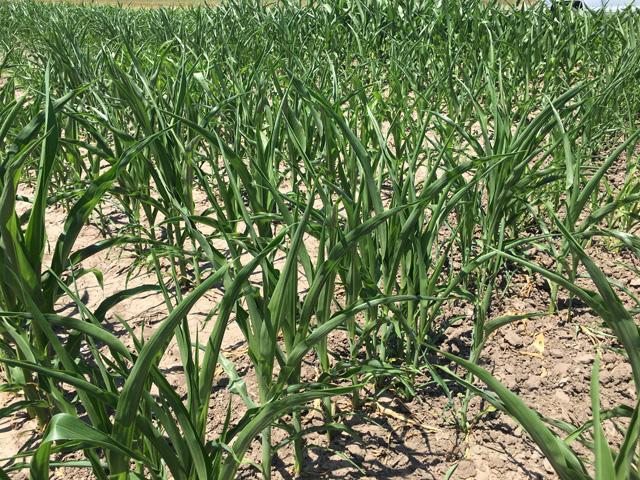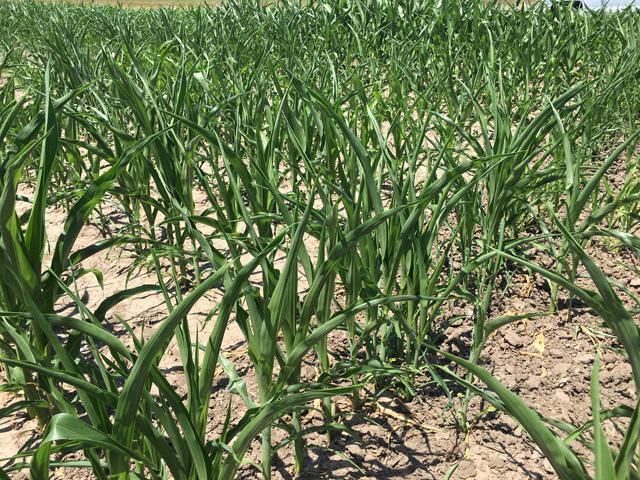Production Blog
Five Signs of Early-Season Drought Stress
JEFFERSON CITY, Mo. (DTN) -- As calendars flip from May to June, summer heat and drier-than-average conditions have crept into some portions of the Corn Belt.
With precipitation deficits mounting across the entire Midwest, abnormally dry conditions expanded across most the region on the updated U.S. Drought Monitor map released June 1. The latest version also revealed more areas of drought ranging from abnormally dry to exceptional drought in the center of the country. The Western Corn Belt is especially dry, and Nebraska, Kansas and Missouri include the largest areas of extreme and exceptional drought of anywhere in the country. (See the latest at https://droughtmonitor.unl.edu/…).
The lack of moisture has allowed planters to roll. As of the USDA Crop Progress Report released May 30, 92% of corn and 83% of soybeans had been planted. However, those crops will need moisture in the coming days. USDA data revealed more than half of the topsoil moisture was short or very short in Iowa (50%), Kansas (50%), Nebraska (57%), Missouri (62%) and Michigan (68%), while 40% or more was short of very short in Wisconsin (45%), Ohio (45%), Illinois (42%) and Indiana (40%). In areas where topsoil moisture is considered short, drought stress may already be causing yield reductions.
Here are five signs that a young corn or soybean crop may be stressed -- and what those signs might mean for your yield potential:
1. FLOPPY CORN -- Young corn plants that just can't seem to stand up may be suffering from rootless corn syndrome, also known as "floppy" corn. It's the result of poor nodal root development, and the issue can occur as early as the V2 growth stage.
Nodal roots are highly sensitive to heat, and their growth may stop once soil surface temperatures reach the mid 90s Fahrenheit. Seed that is planted too shallow or planted into dry topsoil may not grow an adequate nodal root system, and the plant will simply fall over from lack of support.
P[L1] D[0x0] M[300x250] OOP[F] ADUNIT[] T[]
Corn that gets "floppy" can recover with timely rainfall. Without it, the corn may wilt and die. Read more about rootless corn syndrome here: https://crops.extension.iastate.edu/….
2. PINEAPPLE CORN -- A lack of rainfall and high temperatures can make a Midwest cornfield look more like a pineapple plantation in Hawaii. To conserve water, corn plants will tightly roll their leaves. This evolutionary adaptation reduces the leaf surface area, lowering its exposure to solar radiation and lessening evaporation.
The reaction can occur during severe and prolonged heat waves as well as during dry, low-humidity days. Poor root development may exacerbate the condition, and yield losses can begin if the corn plants stay curled for multiple days. Read more about pineapple corn here: https://www.dtnpf.com/….
3. STREAKED CORN -- Dry soils make it more difficult for crops to uptake many nutrients, especially potassium, which moves to the roots by diffusion. Without moisture, this process can be reduced drastically. Potassium deficiency can be especially troublesome as it can worsen existing drought stresses. The nutrient plays a key role in regulating the opening and closing of stomata. Without sufficient potassium, corn plants are slower to close stomata, resulting in more moisture loss.
The uptake of several micronutrients, including zinc and magnesium, also can be reduced and cause streaking on corn leaves. Read more about drought and nutrient deficiencies here: https://www.canr.msu.edu/….
4. PAUSED BEANS -- Young soybeans facing early-season drought stress will hit the "pause" button on growth, leading to shorter plants with smaller leaves. This can lead to limited row closure, which could allow more weed competition. The plants may also transition from vegetative to reproductive growth earlier, potentially setting pods that may only be a few inches off the ground.
5. LEAF FLIPPING AND CLAMPING -- Much like corn plants will alter the shape of their leaves to reduce solar radiation and moisture loss, soybeans will also adjust their leaf orientation. It begins with leaf flipping, where the plants expose the silvery underside of the leaves to conserve water.
Should the drought stress become more severe, the plants will progress to "leaf clamping." The outer leaflets of trifoliates will clamp together to reduce leaf area exposed to sunlight, sometimes sandwiching the center leaflet in between. Read more about soybean drought stress here: https://www.agry.purdue.edu/…
According to Iowa State University information, when drought stress occurs for four or more consecutive days, yield reductions during early vegetative stages can reduce corn yields by 1% to 3% per day of stress. Drought stress throughout reproductive stages can cause 10% to 50% yield losses, with the greatest losses occurring during silking and pollen shed.
In general, soybeans are less susceptible to drought stress. The plants will abort both flowers and pods during short-term stresses, then produce new flowers and pods should conditions improve. Iowa State estimates that drought can reduce pod numbers by up to 20% and result in a shortening of the grain-filling period that lowers yields.
Read more about the influence on both corn and soybeans here: https://crops.extension.iastate.edu/…
Jason Jenkins can be reached at jason.jenkins@dtn.com
Follow him on Twitter @JasonJenkinsDTN
(c) Copyright 2023 DTN, LLC. All rights reserved.






Comments
To comment, please Log In or Join our Community .